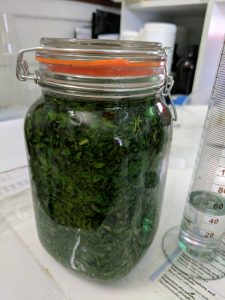Ragweed – is it the problem, or the answer?
Ragweed!
Though ragweed is common across many parts of the world, we probably grow more of it on our 100 acres than I’ve ever seen anywhere! .
.
When I take the tractor out to slash weeds I need to dress up like a World War 1 vet, donned in full suit and gas mask
I get hay fever so bad, I itch and sneeze for days after a mow!
Ragweed is well known in the Northern Rivers and pollenates here (when the seasons behave themselves), in March, April & May. Not only does ragweed seem to grow anywhere, each annual weed produces It produces copious amounts of pollen – usually in the millions of grains. Designed to be aerodynamic, this pollen can travel thousands of kays from a parent plant. The pollen grains are released in clumps, held together with a sticky substance called pollenkitt. These clumps break apart in the air, allowing the grains to be distributed far and wide. Ragweed’s florets have a bottlebrush-like mechanism to ensure the plant pushes out every last irritating pollen grain.
Unfortunately for those of us with environmental allergies, ragweed pollen grains are also potent, able to turn human beings into wet tissues.
So is it war?
Before you beat a path to your local pharmacist to purchase crates of the latest pharmaceutical sneezagon tablets that you see advertised on TV, have a think about possible healthier options. If you are like me you are so keen to breathe more clearly you don’t bother reading the leaflet in the box. Even if you did see the words “Side effects”, you probably wouldn’t consider they could apply to you.
Check out these side effects published by one popular allergy medication:
- This drug may make you dizzy or drowsy. Do not drive, use machinery, or do any activity that requires alertness until you are sure you can perform such activities safely. Limit alcoholic beverages.
- Children may be more sensitive to the side effects of this product, especially excitation and agitation
- Older adults may be more sensitive to the side effects of this product, especially dizziness, drowsiness, confusion, constipation, fast/irregular heartbeat, trouble sleeping, or urination problems. Dizziness, drowsiness, trouble sleeping, and confusion can increase the risk of falling.
- During pregnancy, this medication should be used only when clearly needed. Discuss the risks and benefits with your doctor.
- This medication may pass into breast milk and the effect on a nursing infant is unknown. Consult your doctor before breast-feeding.
The packet warns if you take it too much or for too long you may suffer hallucinations, seizure and even death. Then there are all the warnings to not take the medication at all if you present with any of a list of conditions.
Old school gardeners and herbalists may have the answer
Its a secret kept by many. Gardeners know that by picking off the top of a ragweed and chewing it they avoid all ragweed’s horrible symptoms. I am not recommending we all go out and eat the stuff, but it does highlight an age old principle in traditional homeopathic medicine.

With just a few drops of a tincture of Ambrosia artemisiifolia (that’s Latin for Ragweed) in my mouth and I can ditch the mask, the itches and the sneezing.
Now I have to come up with another excuse not to mow!
